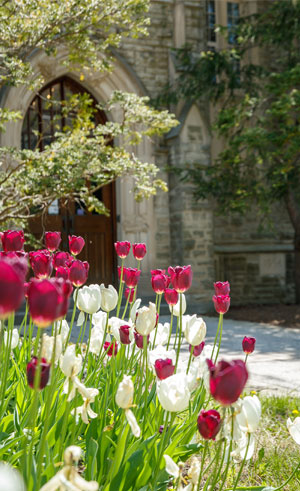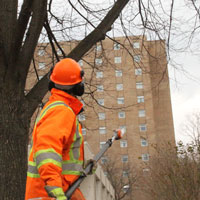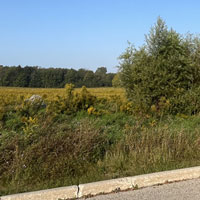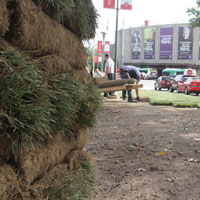Campus Landscape Services

Ecology and landscape initiatives
Facilities Management typically carries out landscape stewardship activities across campus to deliver a safe and beautiful outdoor environment for our community.
Our most common activities include:
- Invasive plant control: Reduction and removal of invasive plants to support biodiversity.
- Tree and plant maintenance: Pruning or removal of trees and shrubs for size and form, plant health or safety.
- Seasonal mowing: Irregular Mowing to control woody invasive species or to control seasonal plant growth in an area.
- Landscape Renovation: Work to restore, update or alter planted areas to enhance aesthetics or support maintenance tasks.
More detail on each of these can be found in the section below.
Invasive plant control
 Western is actively engaged in controlling invasive plant species as part of its broader commitment to biodiversity and ecological restoration. One notable initiative is the “Buckthorn Bust”, a hands-on project led by students in the Master of Environment and Sustainability program. This effort targets common buckthorn (Rhamnus cathartica), a highly invasive shrub that has spread across North America and poses serious threats to native ecosystems. Buckthorn degrades soil quality, inhibits native plant growth, and produces berries that offer poor nutritional value to wildlife, contributing to its rapid spread via birds.
Western is actively engaged in controlling invasive plant species as part of its broader commitment to biodiversity and ecological restoration. One notable initiative is the “Buckthorn Bust”, a hands-on project led by students in the Master of Environment and Sustainability program. This effort targets common buckthorn (Rhamnus cathartica), a highly invasive shrub that has spread across North America and poses serious threats to native ecosystems. Buckthorn degrades soil quality, inhibits native plant growth, and produces berries that offer poor nutritional value to wildlife, contributing to its rapid spread via birds.
By reducing invasive species like buckthorn, Western supports the regeneration of native plant communities and enhances the ecological health of its campus, particularly along the Thames River corridor. These efforts reflect the university’s dedication to sustainability and its role in fostering a biodiverse, resilient landscape for future generations.
Tree and plant maintenance
 Western maintains its reputation as one of Canada’s most beautiful campuses through dedicated tree and plant care practices. FM oversees the health and safety of campus greenery, including trees, shrubs, and flower beds. Work includes pruning, trimming, cultivating, and removing vegetation as needed to maintain proper size, form, and vitality. These efforts are essential not only for aesthetic appeal but also for ensuring safety and supporting biodiversity across campus.
Western maintains its reputation as one of Canada’s most beautiful campuses through dedicated tree and plant care practices. FM oversees the health and safety of campus greenery, including trees, shrubs, and flower beds. Work includes pruning, trimming, cultivating, and removing vegetation as needed to maintain proper size, form, and vitality. These efforts are essential not only for aesthetic appeal but also for ensuring safety and supporting biodiversity across campus.
Tree and shrub maintenance at Western is guided by seasonal needs and ecological considerations. Pruning helps prevent disease, improves structural integrity, and reduces hazards such as falling branches. When removal is necessary—due to poor health, invasive growth, or safety risks—it is done with care to minimize environmental impact. These practices contribute to a healthier campus ecosystem, especially along the Thames River corridor, and align with Western’s broader sustainability goals.
Trees of 50 diamater or more that are removed for project work will be replaced one for one.
Seasonal mowing
 FM uses seasonal mowing as a strategic tool to manage plant growth and control invasive woody species across its campus landscapes. This practice is especially important in open areas and naturalized zones where invasive plants—such as buckthorn and non-native honeysuckle—can quickly dominate and suppress native biodiversity if left unchecked.
FM uses seasonal mowing as a strategic tool to manage plant growth and control invasive woody species across its campus landscapes. This practice is especially important in open areas and naturalized zones where invasive plants—such as buckthorn and non-native honeysuckle—can quickly dominate and suppress native biodiversity if left unchecked.
Seasonal mowing is irregular and ecologically timed to disrupt the life cycles of invasive species without harming native plants. By cutting back vegetation before invasive species can seed or spread, the university helps maintain open habitats and supports the regeneration of native flora. This method complements other invasive species management efforts on campus, such as manual removal and succession planting, and aligns with Western’s broader sustainability goals to protect the Carolinian forest ecosystem and enhance biodiversity along the Thames River corridor.
Landscape renovation
 Landscape renovation projects to enhance the beauty, functionality, and ecological health of its campus. These renovations involve restoring or updating planted areas to improve aesthetics, support maintenance, and align with sustainability goals. Whether it's redesigning gardens, replacing aging vegetation, or installing new plantings, the university’s approach emphasizes ecological integrity and long-term stewardship.
Landscape renovation projects to enhance the beauty, functionality, and ecological health of its campus. These renovations involve restoring or updating planted areas to improve aesthetics, support maintenance, and align with sustainability goals. Whether it's redesigning gardens, replacing aging vegetation, or installing new plantings, the university’s approach emphasizes ecological integrity and long-term stewardship.
A key example is the transformation of Kent Walk, where overgrown vegetation and outdated infrastructure were replaced with native and ornamental plantings, seating areas, and improved lighting. This project not only elevated the visual appeal of the space but also supported pedestrian safety and accessibility.
Across campus, renovations often include the use of native species, drought-tolerant plants, and pollinator-friendly gardens, all contributing to Western’s commitment to biodiversity and sustainable land management. Plants are selected based on the conditions of each location in which they will be planted considering water requirements, soil type and condition and other factors that affect the long term growth and vitality of the plants selected.
